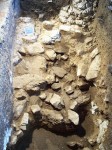 It’s a stone wall built at the entrance to Theopetra cave near Kalambaka, Greece, and it’s a whopping 23,000 years old.
It’s a stone wall built at the entrance to Theopetra cave near Kalambaka, Greece, and it’s a whopping 23,000 years old.
The wall — which is basically an intentional pile of stones — blocks 2/3rds of the cave mouth. It was built during the coldest period of the most recent ice age, so its builders were probably trying to keep the cold winds out of their cave dwelling.
“An optical dating test, known as Optically Stimulated Luminescence, was applied on quartz grains nested within the stones. We dated four different samples from the sediment and soil materials, and all provided identical dates,” Nikolaos Zacharias, director of the laboratory of archaeometry at the University of Peloponnese, told Discovery News.
Archaeologists have been excavating Theopetra cave for 25 years now, and have found a large number of material remains ranging in age from 50,000 to 5,000 years old. The remains suggest that the cave was continually inhabited for 45,000 years.
They’ve found the remains of multiple fires, flint and quartz tools, pottery, jewelry made from the teeth of early elk, animal bones and barley, wheat and lentils both wild and cultivated, suggesting that the people who lived in that cave went from foraging to farming over the millennia.
Theopetra is the only site in Greece that show continuous use through the upper and middle Paleolithic Age, the Mesolithic and Neolithic eras.
Human footprints have been found, one barefoot, three covered, in the deeper layers of the cave. Carbon-14 dating of fire remains at that cave level indicate those footprints were made around 45,000 B.C. In mainland Europe Neanderthal remains date to that time, so it’s possible that this cave has not only seen Homo Sapiens Sapiens shift from hunter-gathering to agriculture, but also humanity itself shift from one species to another.